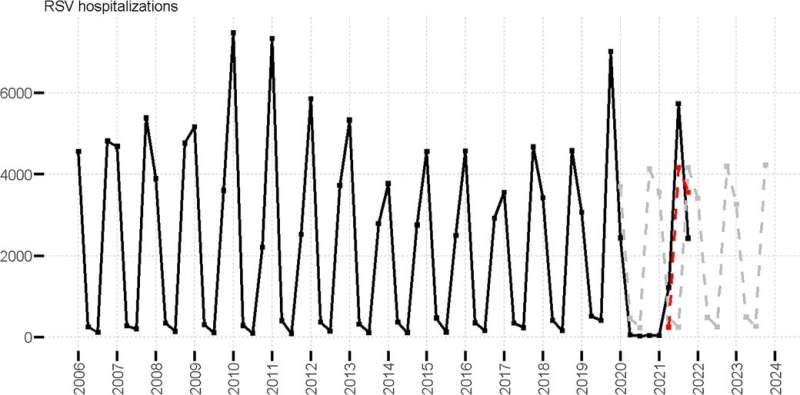This article has been reviewed according to Science X's editorial process and policies. Editors have highlighted the following attributes while ensuring the content's credibility:
fact-checked
trusted source
proofread
RSV hospitalizations spiked unusually high in late 2021, study finds

The COVID-19 pandemic posed an immense challenge for the health care industry in 2020 and 2021. While hospitals were inundated with COVID-19 cases, other illnesses such as respiratory syncytial virus (RSV) saw a decrease in hospital visits, particularly in the fourth quarter of 2020 and the first quarter of 2021.
A Texas A&M University School of Public Health study recently published in the journal Frontiers has found that while there were an unusually low number of hospitalizations in 2020, there was an unusual peak in the third quarter of 2021, when hospital admissions for RSV were approximately twice those in a typical year.
"We found some really interesting data," said Itza Mendoza-Sanchez, Ph.D., assistant professor in the Department of Environmental and Occupational Health (EOH) and one of the lead authors on the study. "We had very low numbers in 2020 because of COVID, but then we saw higher numbers in 2021."
"Kids were not going into daycare and getting that exposure (to RSV), and that mirrored the dynamic," added Natalie Johnson, Ph.D., associate professor in EOH, and one of the lead authors of the study,
RSV is a common airway pathogen that most frequently results in mild, cold-like respiratory tract infections. In children younger than two years of age, RSV infection can result in severe lower respiratory illness, including acute bronchiolitis or pneumonia.
The seasons are usually a strong predictor of RSV infection, with activity typically occurring in late fall, winter and early spring, peaking from late December to mid-February. According to the researchers, however, the COVID-19 pandemic had an effect on RSV seasonality.
Additionally, the researchers found that the length of hospital stays in relation to RSV, which typically followed a seasonal trend prior to COVID-19, was longer during the pandemic despite the lower number of cases.
"We can only hypothesize that during COVID they were only accepting the extreme cases, and on average the length of stay was longer," Mendoza-Sanchez said. "We learned that what has happened in the past is informing us that if something similar happens in the future we have to be ready for the peaks in cases."
Additional authors on the paper include Inyang Uwak, Toriq Mustapha, Mariya Rahman and Tanaya Tonpay, all from the Department of Environmental & Occupational Health, and Annette K. Regan from the School of Nursing and Health Professions at the University of San Francisco.
More information: Inyang Uwak et al, Quantifying changes in respiratory syncytial virus—associated hospitalizations among children in Texas during COVID-19 pandemic using records from 2006 to 2021, Frontiers in Pediatrics (2023). DOI: 10.3389/fped.2023.1124316


















